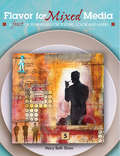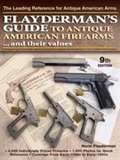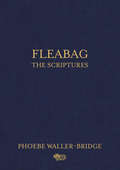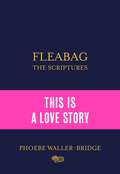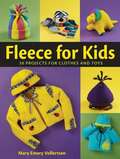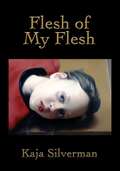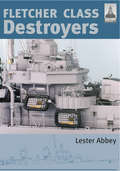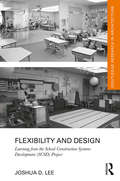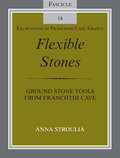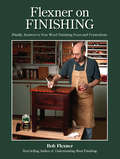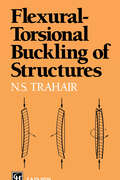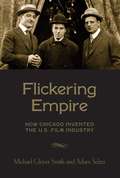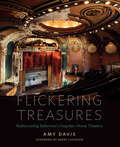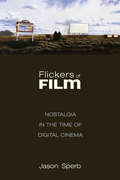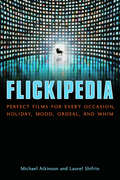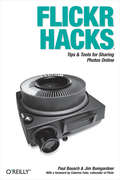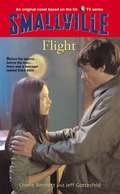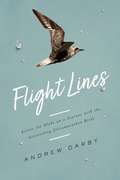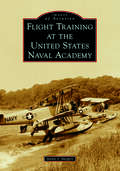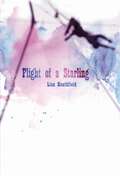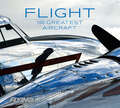- Table View
- List View
Flavor for Mixed Media: A Feast of Techniques for Texture, Color and Layers
by Tonia Davenport Mary Beth ShawIt's time to cook up some creativity! You're invited to a fanciful feast of color, textures and luscious layers that will tempt even the most discriminating painter's palette. Whether you love experimenting with your own flavors, or following a recipe to a 'T,' Flavor of Mixed Media will be your guide to handcrafting some of your most delectable works of art yet! Artist Mary Beth Shaw will share her mixed media painting techniques for working with color, incorporating many different textures, creating multiple layers, developing a distinct flavor and making all sorts of clever combinations. In addition to home-style favorite such as collage tips and tricks, and inspiring works by "dinner guest" artists, other things you'll sample from this menu include: How to experiment with color mixing and develop your own tasty triads Achieving texture with unusual tools such as a cheese grater or stencils or "icing" Clever new ways to use what's already in your art-making pantry Creating depth to your work with cutout shapes or Plexiglas Doodling bookmaking, collagraph printing, actual food recipes and more! Clear off the counter and get cooking! Let Flavor for Mixed Media tempt your "palette" today.
Flaxman's Illustrations for Dante's Divine Comedy
by John FlaxmanSince its creation at the beginning of the fourteenth century, Dante's Divine Comedy--a masterpiece of European literature--has moved legendary artists such as William Blake and Gustave Doré to illustrate the famed poem. John Flaxman, English sculptor, draughtsman, and renowned Wedgwood designer, was no exception. Commissioned at the end of the eighteenth century by famed art collector and author Thomas Hope, Flaxman's 110 illustrations of the Divine Comedy are known as his greatest achievement. Deceptively simple, awash in pathos, and recalling antique imagery in a classically Greek style, they themselves became an inspiration for such artists as Goya and Ingres, and were used as an academic source for nineteenth-century art students. This magnificent edition of Flaxman's Illustrations for Dante's Divine Comedy includes the complete series of drawings created by Flaxman for all 99 cantos of the literary masterwork. A glorious collection of lively outlines that captures the very spirit of Dante's poem, it is an essential addition to the bookshelves of art, literature, and history enthusiasts. Captions are included from the Henry Wadsworth Longfellow translation of the original text.
Flayderman's Guide to Antique American Firearms and Their Values: The Leading Reference for Antique American Arms (9th edition)
by Norm FlaydermanWith meticulously researched data, and descriptions of stampings and markings for more than 4,000 antique American firearms, Flayderman's work is truly the ultimate value guide.
Fleabag: The Scriptures
by Phoebe Waller-BridgeGo deeper into the groundbreaking, Emmy-winning series with this must-have collection—&“a completist&’s dream of a book, including the show&’s full scripts and Waller-Bridge&’s commentary&” (Vogue). &“Her coat falls open. She only has her bra on underneath. She pulls out the little sculpture of the woman with no arms. It sits on her lap. Two women. One real. One not. Both with their innate femininity out.&” Phoebe Waller-Bridge&’s critically acclaimed, utterly unique series Fleabag took the world by storm with its piercing dialogue, ruthlessly dry wit, and deeply human drama. In Fleabag: The Scriptures, Waller-Bridge brings together for the first time the complete filming scripts of the first and second seasons, annotated with never-before-seen stage directions and exclusive commentary on her creative process and the making of the series. Now recognized as one of today&’s most essential voices, she delivers powerful insights into her now-iconic protagonist: the hilarious, emotionally damaged, sexually unapologetic woman who can make viewers laugh, cry, and cringe in a single scene. Essential for any fan, Fleabag: The Scriptures is the ultimate companion to a landmark series.
Fleabag: The Sunday Times Bestseller (Nhb Modern Plays Ser.)
by Phoebe Waller-BridgeBestseller in the UK, Sunday Times, November 2019.The complete Fleabag. Every Word. Every Side-eye. Every Fox.Fleabag: The Scriptures includes new writing from Phoebe Waller-Bridge alongside the filming scripts and the never-before-seen stage directions from the Golden Globe, Emmy and BAFTA winning series. 'Perfect' Guardian'Perfect' Daily Telegraph'Perfect' Stylist 'Perfect' Independent'Perfect' Evening Standard 'Perfect' Metro'Perfect' Irish Times 'Perfect' RTE'Perfect' Spectator'Perfect' Refinery29'Perfect' Catholic Herald'Perfection' Financial Times***HAIRDRESSERNO.(pointing to Claire)That is EXACTLY what she asked for.FLEABAGNo it's not. We want compensation.HAIRDRESSERClaire?CLAIREI've got two important meetings and I look like a pencil.HAIRDRESSERNO. Don't blame me for your bad choices. Hair isn't everything.FLEABAGWow.HAIRDRESSERWhat?FLEABAGHair. Is. Everything. We wish it wasn't so we could actually think about something else occasionally. But it is. It's the difference between a good day and a bad day. We're meant to think that it is a symbol of power, a symbol of fertility, some people are exploited for it and it pays your fucking bills. Hair is everything, Anthony.
Fleece for Kids
by Mary Emery VollertsenFun, fuzzy and fleece! High-style fleece clothing and toys are affordable and easy with author Mary Vollertsen's step-by-step instructions. Boutique-style clothing will keep your children warm and have your friends talking. By adjusting basic patterns and embellishing with smoking, painting ribbons or applique, you can make a jacket, pullover or hat to fit any personality. Even create toys with simple, step-by-step soft-sculpture techniques. From smoked balls to a baby dinosaur, these toys make great playmates and great gifts.
Flesh of My Flesh
by Kaja SilvermanSilverman (rhetoric and film studies, University of California, Berkeley) argues for a return to analogy, of seeing ourselves as part of a whole. She sees life as a conflict between the desire for unity and the need to be unique. While drawing from a number of sources, including Freud, Rilke, Proust, Leonardo Da Vinci and Nietzsche, her primal metaphors are from Ovid's Metamorphosis, especially the story of Orpheus and Eurydice. In the first half of the book, she concentrates on nineteenth century redactions of the myth. The ways in which artists and philosophers tackled the dichotomy is shown as entwined with a sense of selfhood but also a sense of mortality. In the second half, Silverman uses the examples of Malick's film The Thin Red Line, the "intervention" created by James Coleman for a 2002 Leonardo exhibit at the Louvre and, lastly, the photographs/paintings of Gerhardt Richter which include images and distortions of death. The book is illustrated throughout, along with a group of colored plates. Annotation c2010 Book News, Inc. , Portland, OR (booknews. com)
Fletcher Class Destroyers (Shipcraft Ser.)
by Lester AbbeyThe 'ShipCraft' series provides in-depth information about building and modifying model kits of famous warship types. Lavishly illustrated, each book takes the modeller through a brief history of the subject class, using scale plans to highlight differences between sisterships and changes in their appearance over their careers, then moves to an extensive photographic survey of either a high-quality model or a surviving example of the ship. Hints on building the model, and on modifying and improving the basic kit, are followed by a section on paint schemes and camouflage, featuring numerous colour profiles and highly-detailed line drawings. The strengths and weaknesses of available kits of the ships are reviewed, and the book concludes with a section on research references—books, monographs, large-scale plans and relevant websites. The subject of this volume is the Fletcher class, often considered the most successful of all American destroyers. Built to the first design that was freed from treaty restrictions, they came into service near the beginning of the Pacific War and fought with distinction through all the most ferocious of the campaigns against Japan. They were constructed in large numbers, with a number of variations, and their popularity is reflected by the wide range of available kits.
Flexibility and Design: Learning from the School Construction Systems Development (SCSD) Project (Routledge Research in Architecture)
by Joshua D. LeeThis book questions flexibility as a design approach by providing a longitudinal analysis of an innovative architectural experiment called the School Construction Systems Development (SCSD) project. The SCSD pioneered the use of performance specifications to create an open, prefabricated, and integrated system of building components that provided four modes of flexibility. Educational facilities throughout California used the SCSD system and it spawned a variety of similar projects throughout North America. This book traces the development and subsequent use of the system over 50 years through archival research, personal observations, re-photography, re-surveying, plan evaluations, interviews, and an advertisement analysis. These new findings provide useful insights for architects, educators, historic preservationists, and others about the affordances of spatial flexibility, the difficulties associated with technological transfer, the impact of unstable market conditions, the importance of user input during the planning process, and the need for long-term social relations to sustain architectural experiments.
Flexible Stones: Ground Stone Tools from Franchthi Cave, Fascicle 14, Excavations at Franchthi Cave, Greece (Excavations at Franchthi Cave, Greece)
by Anna StrouliaDespite their ubiquitous presence among prehistoric remains in Greece, ground stone tools have yet to attract the same kind of attention as have other categories of archaeological material, such as pottery or lithics. Flexible Stones provides a detailed analysis of the material discovered during the excavations at Franchthi Cave, Peloponnese, Greece. Approximately 500 tools, the raw material used for their manufacture, as well as the byproducts of such manufacture were found. Most of this collection comes from the Neolithic component of the site—including a small number of Palaeolithic and Mesolithic cases—with a large number of the studied tools indicating multiple uses. Anna Stroulia sees the multifunctional character of these tools as a conscious choice that reflects a flexible attitude of tool makers and users toward tools and raw materials. A CD-Rom with 209 additional plates is included.
Flexner on Finishing: Finally - Answers to Your Wood Finishing Fears & Frustrations
by Bob FlexnerEverything You Need to Finish Your Woodworking Projects Like a Pro No more mystery. No more hype. Told as it is. Take control of finishing by learning how to use the many finishes available-and what those products actually are. In this book, his first since Understanding Wood Finishing, Bob Flexner delves deeper into many of the issues woodworkers struggle with and he does it with an authority that leaves no doubt. Inside, you'll discover the truth about: Wood Preparation Choosing a Finish Coloring Wood Brushing & Spraying Overcoming Finishing Problems Finishing Myths Repairing Finishes And So Much More! BONUS CHAPTER on Furniture Repair!
Flexural-Torsional Buckling of Structures
by Nick TrahairThis book provides an up-to-date and comprehensive treatment of flexural-torsional buckling, and shows how to design against this mode of failure. It also gives detailed summaries of knowledge on flexural-torsional buckling so that it can be used as a source book by practising engineers and designers, researchers and advanced students of structural
Flickering Empire: How Chicago Invented the U.S. Film Industry
by Adam Selzer Michael Glover SmithTells the fascinating but too little known story of how Chicago served as the unlikely capital of film production in America in the years prior to the rise of Hollywood (1907-1913)
Flickering Empire: How Chicago Invented the U.S. Film Industry
by Adam Selzer Michael Glover SmithFlickering Empire tells the fascinating yet little-known story of how Chicago served as the unlikely capital of American film production in the years before the rise of Hollywood (1907–1913). As entertaining as it is informative, Flickering Empire straddles the worlds of academic and popular nonfiction in its vivid illustration of the rise and fall of the major Chicago movie studios in the mid-silent era (principally Essanay and Selig Polyscope). Colorful, larger-than-life historical figures, including Thomas Edison, Charlie Chaplin, Oscar Micheaux, and Orson Welles, are major players in the narrative—in addition to important though forgotten industry titans, such as "Colonel" William Selig, George Spoor, and Gilbert "Broncho Billy" Anderson.
Flickering Treasures: Rediscovering Baltimore's Forgotten Movie Theaters
by Amy DavisThe riveting story of Baltimore’s movie theaters over the past century, eloquently told through extraordinary photographs and poignant reminiscences.2018 Winner of the Preservation Award of the Baltimore HeritageBaltimore has been home to hundreds of theaters since the first moving pictures flickered across muslin sheets. These monuments to popular culture, adorned with grandiose architectural flourishes, seemed an everlasting part of Baltimore’s landscape. By 1950, when the city’s population peaked, Baltimore’s movie fans could choose from among 119 theaters. But by 2016, the number of cinemas had dwindled to only three. Today, many of the city’s theaters are boarded up, even burned out, while others hang on with varying degrees of dignity as churches or stores. In Flickering Treasures, Amy Davis, an award-winning photojournalist for the Baltimore Sun, pairs vintage black-and-white images of opulent downtown movie palaces and modest neighborhood theaters with her own contemporary full-color photographs, inviting us to imagine Charm City’s past as we confront today’s neglected urban landscape. Punctuated by engaging stories and interviews with local moviegoers, theater owners, ushers, and cashiers, plus commentary from celebrated Baltimore filmmakers Barry Levinson and John Waters, the book brings each theater and decade vividly to life. From Electric Park, the Century, and the Hippodrome to the Royal, the Parkway, the Senator, and scores of other beloved venues, the book delves into Baltimore’s history, including its troubling legacy of racial segregation. The descriptions of the technological and cultural changes that have shaped both American cities and the business of movie exhibition will trigger affectionate memories for many readers. A map and timeline reveal the one-time presence of movie houses in every corner of the city, and fact boxes include the years of operation, address, architect, and seating capacity for each of the 72 theaters profiled, along with a brief description of each theater’s distinct character. Highlighting the emotional resonance of film and the loyalty of Baltimoreans to their neighborhoods, Flickering Treasures is a profound story of change, loss, and rebirth.
Flickering Treasures: Rediscovering Baltimore's Forgotten Movie Theaters
by Amy DavisThese vintage and contemporary images of Baltimore movie palaces explore the changing face of Charm City with stories and commentary by filmmakers.Since the dawn of popular cinema, Baltimore has been home to hundreds of movie theaters, many of which became legendary monuments to popular culture. But by 2016, the number of cinemas had dwindled to only three. Many theaters have been boarded up, burned out, or repurposed. In this volume, Baltimore Sun photojournalist Amy Davis pairs vintage black-and-white images of downtown movie palaces and modest neighborhood theaters with her own contemporary color photos. Flickering Treasures delves into Baltimore’s cultural and cinematic history, from its troubling legacy of racial segregation to the technological changes that have shaped both American cities and the movie exhibition business. Images of Electric Park, the Century, the Hippodrome, and scores of other beloved venues are punctuated by stories and interviews, as well as commentary from celebrated Baltimore filmmakers Barry Levinson and John Waters.A map and timeline reveal the one-time presence of movie houses in every corner of the city, and fact boxes include the years of operation, address, architect, and seating capacity for each of the 72 theaters profiled, along with a brief description of each theater’s distinct character.
Flickers of Film
by Jason SperbWhether paying tribute to silent films in Hugo and The Artist or celebrating arcade games in Tron: Legacy and Wreck-It-Ralph, Hollywood suddenly seems to be experiencing a wave of intense nostalgia for outmoded technologies. To what extent is that a sincere lament for modes of artistic production that have nearly vanished in an all-digital era? And to what extent is it simply a cynical marketing ploy, built on the notion that nostalgia has always been one of Hollywood's top-selling products? In Flickers of Film, Jason Sperb offers nuanced and unexpected answers to these questions, examining the benefits of certain types of film nostalgia, while also critiquing how Hollywood's nostalgic representations of old technologies obscure important aspects of their histories. He interprets this affection for the prehistory and infancy of digital technologies in relation to an industry-wide anxiety about how the digital has grown to dominate Hollywood, pushing it into an uncertain creative and economic future. Yet he also suggests that Hollywood's nostalgia for old technologies ignores the professionals who once employed them, as well as the labor opportunities that have been lost through the computerization and outsourcing of film industry jobs. Though it deals with nostalgia, Flickers of Film is strikingly cutting-edge, one of the first studies to critically examine Pixar's role in the film industry, cinematic representations of videogames, and the economic effects of participatory culture. As he takes in everything from Terminator: Salvation to The Lego Movie, Sperb helps us see what's distinct about this recent wave of self-aware nostalgic films--how Hollywood nostalgia today isn't what it used to be.
Flickipedia: Perfect Films for Every Occasion, Holiday, Mood, Ordeal, and Whim
by Michael Atkinson Laurel ShifrinFrom the jolting summer electricity of Jaws to mending a broken heart with When Harry Met Sally, this entertaining and unique guide takes movies off the silver screen, offering viewing recommendations tailored to everyday situations. Equipped with more than 1,300 movie suggestions, this informative resource covers every landmark event, social situation, and annual occurrence from having a baby to watching the Super Bowl. Organized by categories such as holidays, seasonal passages, life phases, and emotional trials and eruptions, this guide recommends movies that readers may not be familiar with, while also featuring the popular classic movie pairings, such as It's a Wonderful Life at Christmas and The Ten Commandments at Passover. Whether readers are looking for a scare on Halloween, packing for a road trip, or yearning for a bygone era, this innovative movie guide has the perfect recommendation.
Flickr Hacks: Tips & Tools for Sharing Photos Online
by Paul Bausch Jim BumgardnerOver two million registered Flickr users and counting have discovered the ease and fun of organizing their photo libraries, showing off their favorite pictures to the world, and securely sharing their private pictures with friends, family, or ad hoc groups. But Flickr's own plethora of intuitive menus, options, and features just scratches the surface. Flickr Hacks goes beyond the basics of storing, sorting, and sharing your photos to the much bigger playground of what's possible. Whether you're a beginner looking to manage your metadata and play with tags, or a programmer in need of a detailed reference of Flickr API methods, you'll find what you're looking for here. In addition to getting under the hood of some of the most popular third-party Flickr toys already in the wild, you'll learn how to: Post photos to your blog directly from your cameraphoneMash up your own photos or others' public pictures into custom mosaics, collages, sliding puzzles, slideshows, or ransom notesBack up your Flickr library to your desktop, and save the comments tooSet random desktop backgrounds and build your own Flickr screensaverGeotag your photos and map your contactsDownload a list of photos and make a contact sheetMake your own Flickr-style tag cloud to visualize the frequency of common tagsBuild a color picker with a dynamic color wheel of Flickr photosFeed photos to your web site and subscribe to custom Flickr feeds using RSSTalk to the Flickr API using your web browser, Perl, or PHP; authenticate yourself and other users; and build custom API applications
Flight (Smallville Young Adult #3)
by Cherie Bennett Jeff GottesfeldThis third adventure based on the WB's hit TV series is by two noted authors who have written screenplays for the show, and follows a young, legendary Clark Kent, Lana Lang, and Lex Luthor, complete with all the thrills and strange happenings that fans of "Smallville" expect.
Flight Lines: Across The Globe On A Journey With The Astonishing Ultramarathon Birds
by Andrew DarbyA trans-world journey with an extraorindary shorebird—from Australia's southern ocean to the Arctic and back—that explores the mysteries of the natural world and its power to heal.As the sun lowered and turned Gulf St Vincent fiery, they each called a high-pitched 'peeooowiii!', flashed their black wing-pits, spread their tail skirts and took flight... In a luminous new boook, Andrew Darby follows the odysseys of two seemingly-humble Grey Plovers, little-known migratory shorebirds, as they take previously uncharted ultramarathon flights from the southern coast of Australia to Arctic breeding grounds. On these death-defying flights they dodge predators, typhoons, exhaustion, and countless other dangers before they can breed...and then survive the jrouney all over again and return south to their feeding grounds. But the greatest threat to these, and other long-distance migrants on the flyway, is China's "dragon economy," which is engulfing their vital Yellow Sea staging spots. In Flight Lines, we meet the dedicated people of all nationalities and backgrounds working to save these intrepid birds, from Russia to Alaska, from the rim of the Arctic Sea to the coasts of the Southern Ocean. Out of their hard-won science Darby finds hope for the birds—an unexpected bright light for our times. But his journey to understand these marvellous birds almost ends when he is suddenly diagnosed with an incurable cancer. Then he finds science coming to his rescue too, as his own story and the journey of these little birds intersect in an unexpected and beautiful way.
Flight Through the Ages: A 50th Anniversary Tribute to the Guild of Aviation Artists
by Artists of Aviation“A joy . . . covers the period from the Great War to the modern era with diversions into air shows and some of the personalities of the Guild.” —War History OnlineFlight Through the Ages was the title of the first annual exhibition of the Guild of Aviation Artists in 1971. This book celebrates 50 years of exhibitions and includes paintings by almost one hundred Guild artists, past and present, depicting aircraft from the earliest airborne activities through to the present day. There are balloons and airships, fighters and bombers from both world wars, including Spitfires and Lancasters, airliners from the early years of air travel through Concorde and on to the present day. There are also gliders and helicopters and the current generation of advanced aircraft among some 200 illustrations, most in full color. Artists include some of the most well-known British artists of their day and the works display imagination and creativity in a variety of different styles and treatments that bring flying machines to life. There are historical scenes and aircraft in their natural environment, showing action and some of the aviators and others from the world of aviation. There is a short history of the Guild and a step-by-step guide to one artist’s approach to the subject.“A magnificent series of images in a variety of styles . . . This is a lovely book in which to browse, feast your eyes and ponder on the magic of aviation.” —Flying in Ireland“Inspiration, pure and simple . . . this book provides a luscious ready reference of many of aviation’s most beautiful creations, each in a moment in time that draws us into its story.” —IPMS/USA
Flight Training at the United States Naval Academy (Images of Aviation)
by Andre J. SwygertThe United States Naval Academy was founded in 1845 in Annapolis, Maryland, after experience showed that the policy of training naval officers solely through shipboard experience was ineffective. The development of aircraft in the early 20th century was a technological change that impacted the academy. The efforts of naval aviation advocates, led by Capt. Washington I. Chambers, resulted in the Navy acquiring its first aircraft in 1911 and basing them near the US Naval Academy where sufficient land and material resources were available to support flight operations. Later, under Supt. Adm. Louis W. Nulton, aviation entered the curriculum as an element of fundamental naval education, taking a place among major subjects such as seamanship and gunnery. Classroom instruction and indoctrination flights provided all midshipmen with a familiarization in aviation as an important element in their development as naval officers before circumstances forced a shift of training to other facilities by 1962.
Flight of a Starling
by Lisa HeathfieldBest friends and sisters Lo and Rita have spent their lives flying through the air on the trapeze under the lights in the big top. The nomadic circus community is a close-knit family, but those bonds are threatened as secrets and lies surface and Lo finds forbidden love with a boy from outside the circus. The two sisters find themselves at odds with each other for the first time as they both search for love and test the limits of family loyalty. Lo must face up to a family member's deception and navigate her newfound love. Will she manage to land on her feet?
Flight: 100 Greatest Aircraft
by Mark PhelpsFacts, photos, stories, and specs of one hundred remarkable flying machines, from the Sopwith Camel to the 747 to the supersonic F-22 Raptor. Of all humanity&’s dazzling innovations, perhaps none captures our imaginations or fuels our inventive spirits as much as flight. In our quest to soar higher, faster, and farther, we&’ve dreamed up airborne wonders that are a sight to behold—like the supersonic F-22 Raptor, stealthily soaring above the clouds, or the Boeing-Stearman PT-17 Biplane, the beautiful starter model that helped a generation earn their wings, or the deluxe Concorde—the first passenger jet to cruise at the speed of sound. These iconic aircraft—and ninety-seven more stunning feats of aeronautical engineering—make up the world&’s most groundbreaking contributions to flight, all curated and collected here by the experts at Flying magazine. In Flight: 100 Greatest Aircraft, there&’s something for every aviation aficionado—from brazen stunt planes to far-from-pedestrian commercial jets, from military marvels to spacecraft that reached dazzling new heights. With its spectacular full-color photographs, fascinating and informative text, and a detailed specifications section, Flight is the essential book for pilots and plane-lovers everywhere.
